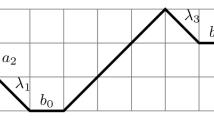Abstract
We introduce a polynomial E(d, t, x) in three variables that comes from the intersections of a family of ellipses described by Euler. For fixed odd integers \(t\ge 3\), the sequence of E(d, t, x) with d running through the integers produces, conjecturally, sequences of “twin composites” analogous to the twin primes of the integers. This polynomial and its lower degree relative R(d, t, x) have strikingly simple discriminants and resolvents. Moreover, the roots of R for certain values of d have continued fractions with at least two large partial quotients, the second of which mysteriously involves the 12th cyclotomic polynomial. Various related polynomials whose roots also have conjecturally strange continued fractions are also examined.
Similar content being viewed by others
References
Apostol, T.M.: A proof that Euler missed: evaluating \(\zeta (2)\) the easy way. Math. Intelligencer 5(3), 59–60 (1983)
Chen, W.: On the polynomials with all their zeros on the unit circle. J. Math. Anal. Appl. 190(3), 714–724 (1995)
Cox, D.A.: Galois Theory. Wiley-Interscience, Hoboken, NJ (2004)
Roy, R.: Elliptic and Modular Functions from Gauss to Dedekind to Hecke. Cambridge University Press, Cambridge (2017)
Acknowledgements
The author thanks the referee for numerous suggestions that significantly improved the readability of this paper.
Author information
Authors and Affiliations
Corresponding author
Additional information
Dedicated to George E. Andrews on the occasion of his 80th birthday
Publisher's Note
Springer Nature remains neutral with regard to jurisdictional claims in published maps and institutional affiliations.
Appendix: More About E
Appendix: More About E
Here, we provide more details about the nature of \(E=E(d, t, x)\) and its relation to \(R=R (d, t,x)\).
Theorem 7.3
Let \(1<t<d\). Then, all roots of the quartic
are real and positive.
Proof
Inspection of the unwieldy solution by radicals formula shows that all roots are real. For \(d=t\), the discriminant is 0, and we have
The roots of the above are all positive, since \(t>1\). It has two distinct roots, each of multiplicity two. As d increases from t, these multiple roots immediately separate into distinct positive roots lying on the real axis, since the roots must remain real. Since the discriminant does not change sign for d in the open interval \((t, \infty )\), the roots remain henceforth distinct and real. If, for some \(d>t\), one of them becomes negative, then, by continuity, one of them became 0 for a smaller value of d. However
so this cannot happen. The result follows. \(\square \)
Remark 7.4
One can show by implicit differentiation that as d increases from t, each of the two double roots separates horizontally into two simple roots at a rate that is initially infinite. However, the ratio of the rate of separation of the larger root to that of the smaller root is the larger root of
We now establish the relationship between E and R.
Theorem 7.5
If we arrange the roots \(s_i\) of \(E(d, t, \sqrt{x})\), so that \(0 \le s_1 \le s_2 \le s_3 \le s_4,\) then the positive square root of \(s_3/s_2\) is a root of R(d, t, x).
Proof
Proceed as in Sect. 5. In \(E(d, t, \sqrt{x})\), replace x by \(\frac{tx}{(2 d^2)}\) and call the new roots the \(s_i'\). This change of variable results in a self-reciprocal polynomial, so \(s_1' s_4' = s_2' s_3' = 1\). Thus, for the original roots, we have
We now apply the cubic resolvent of Sect. 3 much as we did with a cubic resolvent in Sect. 5. We obtain
and
Division of the second of the above equations by \(s_2 s_3 = s_1 s_4\) yields
and similarly, the third yields
Now, \(x + (1/x)=r\) is equivalent to \(x^2-rx+1=0\) and a simple calculation with resultants shows that if also \(y^2 - sy +1 = 0,\) then xy is a root of \(T = T (r, s, z)\), where
Thus, to find a multiple of the minimal polynomial of
we simply use the values of r and s provided by the above equations. Computer algebra then yields the factorization
Thus, the positive square root of the ratio is a root of R(d, t, z) and the result follows. \(\square \)
Rights and permissions
About this article
Cite this article
Stolarsky, K.B. Twin Composites, Strange Continued Fractions, and a Transformation that Euler Missed (Twice). Ann. Comb. 23, 1087–1104 (2019). https://doi.org/10.1007/s00026-019-00469-0
Received:
Accepted:
Published:
Issue Date:
DOI: https://doi.org/10.1007/s00026-019-00469-0
Keywords
- Continued fraction
- Cyclotomic polynomial
- Discriminant
- Ellipse
- Pythagorean triple
- Resolvent
- Resultant
- Twin composites




